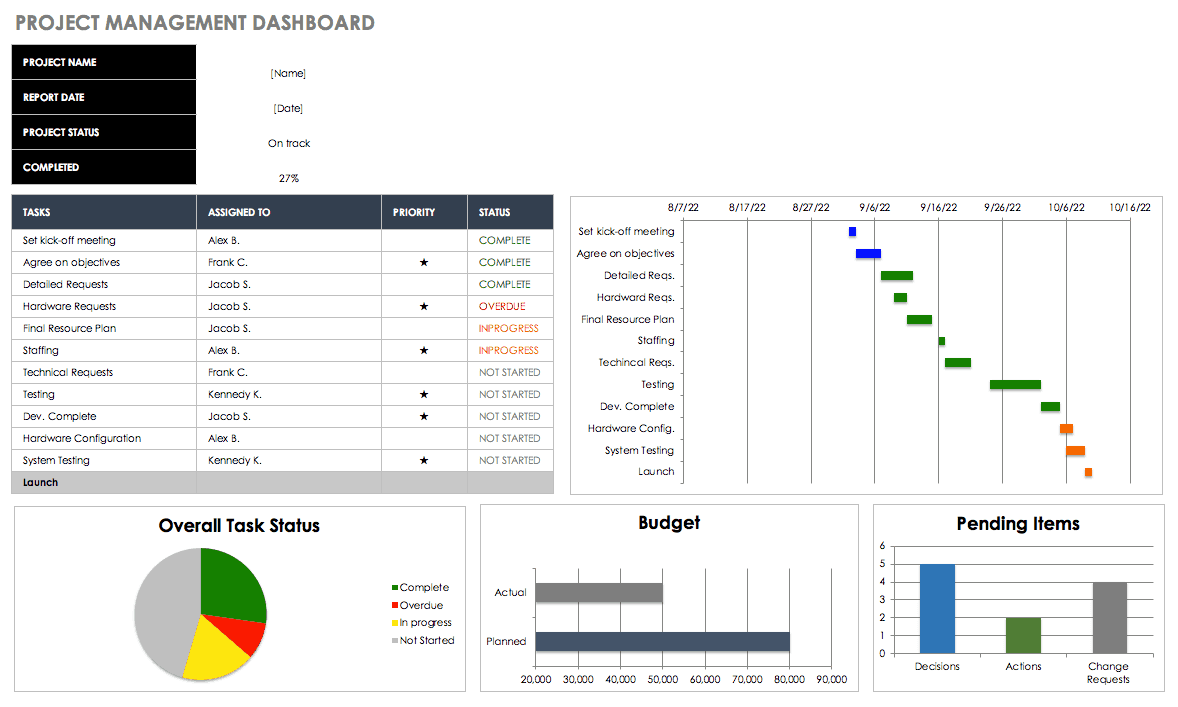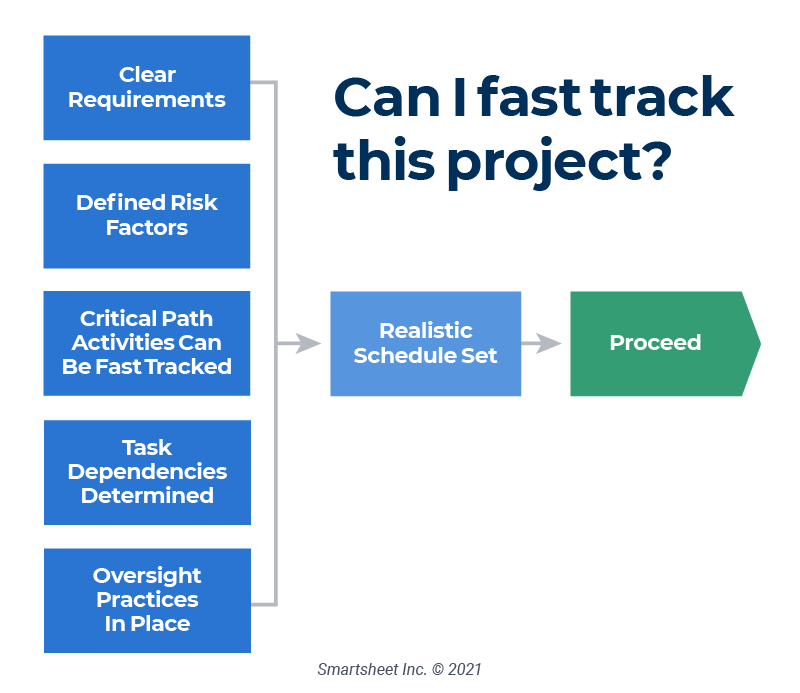What Is Fast Tracking in Project Management?
Project managers use several tools and techniques to meet critical deadlines. One of the most effective is fast tracking or multitrack scheduling. The method delivers end products sooner by completing tasks in parallel with no change in scope.
“When deadlines are abbreviated, overlapping tasks to shorten project schedules is often the way to go,” says Bonnie Biafore, a project management consultant and author of Your Project Management Coach: Best Practices for Managing Projects in the Real World. “Fast tracking is not a project manager’s first choice, but is often a necessity. And it makes management happy, since it doesn’t require adding more money to the project budget.”
What Is Schedule Compression?
The term schedule compression refers to the use of various techniques to shorten schedules. Project managers compress schedules when project tasks fall behind a set due date, finish a project sooner than scheduled, or take advantage of a new business opportunity.
“Schedule compression decreases the project duration without impacting the scope,” says Praveen Malik, PMP, project management instructor, coach, and advisor. “Project managers have several schedule compression tools and techniques they can use to meet critical deadlines. Depending on the deadline shift and project complexity, applying more than one technique can provide an answer.”
Schedule-compression techniques include the following:
- Crashing: Using this method, you add paid resources to a project to make up time on critical path activities.
- Resource Reallocation: This term refers to the transition of resources (people or equipment) from non-critical to critical activities in order to shorten the critical path. This technique doesn’t change the scheduling sequences like fast tracking does, nor does it require adding to the budget.
- Mixed Techniques: You can combine fast tracking, crashing, and resource reallocation to speed up the process under a tight deadline or, if you experience a crashing budget, for high-visibility or mission-critical projects.
“Combining techniques can be the only way forward when schedules shrink,” says Biafore. “You can overlap tasks and decide to spend money if the project is critical, you have ample funds, and you’re able to reallocate personnel.”
Project Management Guide
Your one-stop shop for everything project management

Ready to get more out of your project management efforts? Visit our comprehensive project management guide for tips, best practices, and free resources to manage your work more effectively.
Fast Tracking vs. Crashing
Fast tracking requires activities in parallel to hit a project deadline, whereas crashing refers to adding resources to a project to meet critical deadlines. Crashing involves adding costs to compress the schedule.
Fast-track project planning requires the team to execute on multiple activities simultaneously. This change in velocity can add stress for team members and take them away from other projects. Although crashing may seem like the easier way to go, it comes with an additional financial investment that may affect the budget for other projects. Therefore, crashing has limits, since it can often increase costs without fulfilling its core purpose and relies on outside vendors and dollars spent.
| Fast Tracking | Crashing | |
| Sequence | Activities overlap or run in parallel | Sequence remains unchanged |
| Resources | Internal or originally budgeted-for outside resources | Outside resources and budget added to critical path activities |
| Cost | No additional cost | Additional budget for personnel, materials, and other resources |
| Risk | Increased risk | High risk or potential loss of control over processes and budget |
What Is the Primary Use of Fast-Track Scheduling?
Fast-track scheduling accelerates project completion to make up for lost time. A team may fast track project execution to meet an updated delivery date, complete a competitive opportunity without scope change, or shorten a project with missed milestones.
“When it comes to fast tracking on its own, you have to understand every element,” Biafore advises. “Review all the critical path items. Determine what is removable, what is movable, and what has to stay in place. When you shorten critical path timelines, the advantages of fast tracking a project may disappear because the risks have increased.”
What Does the Fast-Tracking Project Delivery Method Require?
Fast tracking requires that you understand project requirements, goals and objectives, client needs, priorities, best practices, and milestones on the critical path.
Biafore says you need to be prepared and aware to fast track a project: “You must know the goals, objectives, and critical path before you make any changes.”
Take a look at the critical path to ascertain which tasks can work in parallel (rather than sequentially) to fast track your project schedule. Determine any points at which the task-relationship dependencies are changeable. Check to make sure that once you’ve fast tracked the project, the critical path remains unchanged. If other critical path tasks last the same length of time, assess the possibility of managing two critical paths (and whether it’s worth the risk of doing so).
Excellent project management relies heavily on understanding critical path. To learn more, read “The Ultimate Guide to the Critical Path Method.”
How to Fast Track a Project
In order to fast track a project, you must understand goals, detail every task, and arrange these tasks in sequence. After considering all the dependencies between tasks, reset the project schedule to show any parallel activities. Finally, confirm all resources to ensure schedule feasibility and monitor progress.
The success of a fast-tracked project schedule depends on your ability to do the following:
- Identify Goals: Understand what the final product must look like upon delivery. Review resource capabilities to ensure that your team can execute on parallel projects at the required speed.
- Examine the Project Schedule: Identify the tasks that you can complete concurrently, along with all of the soft and hard dependencies.
- Find Opportunities: Look at schedule adjustment options to meet the deadline and adjust accordingly.
- Confirm All Resources: Before you set and distribute the new fast-tracked schedule, verify all needed resources to ensure you can meet your revised plan.
- Monitor Consistently: Track multiple tasks, manage issues as they arise, and resolve problems immediately to stay on schedule.
After you complete the project, review every aspect of the fast-tracked schedule. See if you can apply it to future projects to deliver in shorter time frames without errors or undue stress on staff or other resources.
Project Management Dashboard
Download Project Management Dashboard
In the event that a deadline moves up and you have no extra budget, you can still hit your goals. Keep your fast-tracked project on target and quickly make adjustments as needed with this template, which allows you to track tasks, how team members spend their time, status, budget, and more at a glance. Use the information you gather on the dashboard for project review.
Examples of Fast-Tracking Projects
Fast-tracking examples exist in every industry that manages projects systematically, which means it applies to virtually every type of for-profit and nonprofit business and government — from marketing promotions to billion-dollar construction projects.
Below are some fast-tracking examples in various industries:
- Book Publishing: Biafore says a typical fast-tracking example from her work occurs in publishing and updating her management books. “Writing or updating a manuscript for a second edition is a long process, but you can break it into chunks to fast track to a hard deadline,” Biafore says. “Portions are edited by section or chapter [which avoids having to wait] for the completion of the entire manuscript.”
- Construction: In construction, the fast-tracking technique offers many benefits, including reduced overhead, loan costs, and inflation impacts during construction. For a Coast Guard project in Boston, Massachusetts, in 2019, speedy construction was critical to meet homeland security targets. With fast-track construction, BlueScope Construction completed the facility two weeks ahead of schedule. The Coast Guard units moved in on time and proceeded with their missions related to homeland security targets.
- Climate Change Mitigation: The Pacific Institute for Climate Solutions (PICS) now has a fast-track program to align COVID-19 recovery with local government climate action in Canada. PICS identifies priority actions for communities to create jobs and works with the Community Energy Association to enhance equity with low environmental impacts. The fast-track program highlights big moves in transportation, buildings, and waste for significant emissions reduction. Also, it offers recommendations for actions in large and small communities to speed economic recovery while mitigating climate hazards.
- Fashion Industry: In the world of fast fashion, the focus isn't on price competition anymore, but rather on creating as many product collections in as little time as possible. Fashion manufacturers now use strategies, including fast tracking, to meet customers' wants in the retail market.
- Marketing and Promotions: Biafore was engaged to create a convention exhibitors booth for a tech company to showcase new product demos. With an immovable deadline, “I said no at first,” says Biafore, “because management had no defined goals. We had to work on that first, and then I created the scope document and began planning.” Once the goals were established, Biafore created the schedule. Because of a series of setbacks, she had to fast track the schedule and create a parallel schedule for critical path items to design and construct the booth, as well as create marketing materials and videos, to execute the project on time and on budget.
- Large-Scale Meetings and Events: Biafore gives a simple example of fast tracking from when she was in charge of a symposium with speakers from around the country. Sponsors were a bit slow in signing up. “To onboard a sponsor, the normal process steps are to sign the contract, make the payment, collect deliverables, and start promotions,” explains Biafore. “To fast track, I started collecting deliverables (step three) before the contracts were signed and payment was collected (steps one and two). The risk of having to redo work is minor.”
- Technology Procurement: Many local governments and utility providers had to procure new technology in light of public health issues to digitize services, bring payments online, and provide safe contactless in-person payments. These entities reviewed their usual processes to see where they could overlap critical path tasks, such as by sending out RFPs, to run schedules in parallel. The goal was to shorten the typically complex, lengthy procurement processes and to maintain high standards — in other words, to cut red tape so they could serve their communities in a timely and prudent manner.
- Product Development: Today, the automotive industry needs to introduce innovative and attractive cars to the marketplace at ever-shorter intervals. Now, car designers start work on product development before a product design is even complete. Traditionally, product development occurs at the end of product design, but more automotive companies now use parallel schedules to stay competitive.
- Civil Engineering: In the wake of severe floods in 2019, the U.S. Army Corps of Engineers in Omaha District decided to use fast tracking to repair flood control projects on the Salt Creek and Papillion Creek Levee Systems. Due to schedule compression, the effort saved billions of dollars of infrastructure and protected several hundred thousand people. With an aggressive schedule, the U.S. Army Corps of Engineers completed the repair design for more than 40 damaged locations and construction documents within 120 days so that repairs could proceed before the next flood season.
- Software Development: Schedule compression is a standard in software development to meet tight deadlines, and the usual solution is to overlap tasks. For instance, the design and construction of an application might change before it is final. The final changes may result in modifying work and forcing some schedule overlap near the end of the project. “It’s a normal practice to create documentation in parallel with development, and then to edit it at the end,” says Biafore. “This creates some rework but allows for earlier delivery. Another software development fast-track project example is testing apps or software changes on a module-by-module basis. That is a time saver, instead of doing all the testing at the end.”
Advantages of Fast Tracking in Project Management
With increased competition, companies feel pressure to bring products and services to market within shorter intervals. Any strategy like fast tracking that gets products or services out the door faster is advantageous, particularly one that incurs no additional costs.
“Fast tracking is a great solution to the inescapable problem of the need to deliver a project in less time for no additional dollars,” Biafore observes. “It’s a fact of any kind of business that wants to remain competitive as the world speeds up.”
Benefits of Fast Tracking in Project Management
Fast tracking in project management offers many advantages, including no additional costs, flexibility in meeting business needs, and an improved reputation for the project management team.
When fast tracking is well-executed, there are multiple benefits to the technique:
- No Additional Costs: Fast tracking as a schedule compression strategy is “free” because the team doesn’t apply any extra dollars to the project. However, there is a cost, as internal team hours may increase to complete overlapping tasks.
- Early Project Delivery: Beating a schedule makes management happy, since doing so delivers the product or service early and opens up time to work on new efforts on behalf of the company or client. Early delivery is a goal for professional project managers as it improves standing in the business community.
- Bringing the Project Back on Schedule: When circumstances hold up progress on a project, fast tracking brings the process back online so you can deliver it at the expected time.
- Frees Up Resources: Early delivery means you can use team time to move on to meet new goals.
- Reputation Boost: Early delivery scores points with management and can improve the company’s reputation with customers, board members, and financial analysts.
- Competitive Advantage: Early delivery of products can make or break a company’s fortunes, particularly in the technology and manufacturing sectors.
Despite all the upsides to fast tracking, consider some disadvantages before you use the strategy.
Disadvantages of Fast Tracking in Project Management
The main disadvantage of project fast tracking is the potential for risks that may occur due to task overlapping and dependencies. To be effective, fast tracking requires a high level of analysis when reorganizing activity sequences.
Risks of Fast Tracking
Fast tracking is inherently risky. Moving at speed, pushing team capabilities, and overlapping tasks all present challenges. It’s critical to perform a project risk analysis during evaluation and planning, rather than creating an action in response to problems when they arise.
“The ‘ugly’ in fast tracking is that you introduce risk because you might have to redo work due to tasks going sideways or out of sync or done incorrectly,” Biafore warns. “Then, you have to think about throwing money at the problem to crash or go into overtime.”
Be aware of these potential risks in fast tracking:
- Project Float Loss: Experienced project managers build in float time, or a time cushion, after establishing due dates for tasks. With tighter schedules, there is no room for error, and that’s when individual tasks, timelines, or even the entire project can go off track.
- Project Step Omission: In the rush to hit a crunch deadline, you may overlook tasks in a manner that can wreak havoc on the final product.
- Misunderstanding Critical Path: Essential steps in a project may be seen as non-essential in a rush to meet a new time frame.
- Critical Path Errors: Some critical paths simply cannot be run simultaneously. If you don’t feel sufficiently knowledgeable or comfortable to compute the critical path, don’t fast track without consulting with experts.
- Inadequate Monitoring: Exert additional effort in monitoring every aspect of the project, especially critical path items, as you move the project through with more velocity than usual.
- Rework: When you fast track and lose project float, it’s more challenging to spot and correct errors. Late project stage changes often lead to rework, which means redoing an activity or process that was done incorrectly the first time around. Although these problems are not limited to fast-tracked projects, the frequency is relatively higher in this approach.
“It is the risk versus cost face-off,” says Malik. “If the risk is low and cost or time savings are high, you should go for fast tracking.”
How to Calculate Risk in Fast-Tracking Project Management
Fast-track strategies often impact projects with risks, which come from project velocity that causes oversights, change orders, modifications, and rework. Although not specific to fast tracking, these risks are a frequent symptom of this strategy.
Malik offers the following fast-risk calculation: “List all the risks involved and qualitatively put a probability (P) and impact (I) number against each of them. By multiplying P and I, the project manager can arrive at a new risk figure. Then, determine the project cost involved per day, in terms of the effort and time reduction in days, due to fast tracking. By multiplying these two figures together, the project manager can arrive at an overall cost reduction and help determine whether you should fast track or not.
“In my experience,” notes Malik, “fast tracking is usually done during the low-risk part of a project, where cost benefits outweigh risk considerations.”
The Origins of Fast Tracking
The terms fast track and fast tracking were first used by the Project Management Institute (PMI) in 2000 in a publication dedicated to managing compressed-duration projects. PMI notes that the method requires constant monitoring and communication.
Fast-Tracking Best Practices
The best practices for fast-tracking projects center on management and leadership skills. Both are necessary to guide and motivate your team when you must shorten a schedule and have little room for error.
“When you start a project and you're building your schedule,” cautions Biafore, “a best practice is not to use fast tracking in the planning stage. You’ll have no wiggle room, and there is no room once the project starts.”
Fast-tracking leadership skills include the following:
- Positive Outlook: Project managers need to convey a spirit of innovation, look beyond challenges, and focus on the end goal.
- Team Motivation: Fast-tracked projects come with risks and can be challenging for everyone involved. That’s why one of the most important tasks of a project manager is to motivate the team to keep the project moving, despite any hurdles that arise, by encouraging a spirit of mutual support and optimism.
- Communication Savvy: Fast tracking demands constant communication — usually daily — with essential team members, outside resources, and interaction and support from senior management.
Fast-tracking management skills include the following:
- Precise Scope Statement: When timelines or tasks change, have the client (whether internal or external) approve a clear, written restatement of scope. With that clarity, you can process only the tasks that lead to the requested product and prevent scope creep.
- Risk Management: Identify all potential risks and create a contingency plan. To manage expectations and help clients understand risk implications, consult with the client to identify and build appropriate strategies.
- Change Management: With fast tracking, team members will complete tasks in different sequences. Leaders need to motivate the team to work in unaccustomed ways and support work through any issues.
- Quality Management: Oversight and communication of the end goal and its essential purpose, as well as maintaining strict controls (despite the changes to speed and overlapping tasks) are critical to the success of fast-tracked projects.
- Stress Management: Crunched time frames are stressful for everyone involved. As such, the project manager needs to find ways to deal with stress and to support team members who feel pressured, which they can do by encouraging breaks, physical exercise, sleep, and good nutrition.
Successfully Fast Track Your Project with Smartsheet for Project Management
From simple task management and project planning to complex resource and portfolio management, Smartsheet helps you improve collaboration and increase work velocity -- empowering you to get more done. The Smartsheet platform makes it easy to plan, capture, manage, and report on work from anywhere, helping your team be more effective and get more done. Report on key metrics and get real-time visibility into work as it happens with roll-up reports, dashboards, and automated workflows built to keep your team connected and informed. When teams have clarity into the work getting done, there’s no telling how much more they can accomplish in the same amount of time. Try Smartsheet for free, today.



